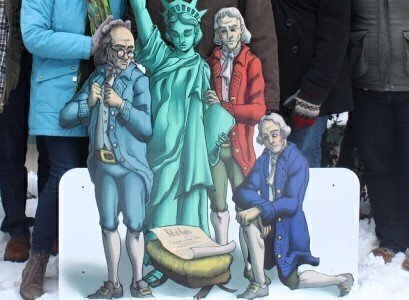As another holiday season approaches, the annual debates about the appropriateness of religious-themed displays on public property continue.
 In past years, the holiday cases and controversies have involved Nativity scenes, an aluminum Festivus pole, a diorama from the Satanic Temple, a holiday greeting from the Church of the Flying Spaghetti Monster and a Bill of Rights-themed Nativity scene.
In past years, the holiday cases and controversies have involved Nativity scenes, an aluminum Festivus pole, a diorama from the Satanic Temple, a holiday greeting from the Church of the Flying Spaghetti Monster and a Bill of Rights-themed Nativity scene.
In 2016, the debates are similar and have broadened to include a Charlie Brown Christmas Special display in a public school that features a Biblical message from the classic TV special.
In Killeen, Texas, a school employee put a Charlie Brown picture on a door that included the following words: “For unto you is born this day in the City of David a Savior which is Christ the Lord’ . . . That’s what Christmas is all about Charlie Brown.’ Linus.”
School officials took down the picture, and the affair wound up in court after state attorney general Ken Paxton filed a lawsuit. A judge allowed the picture to go back up on the condition that there was a disclaimer that the message indicated the employee’s viewpoint.
Nativity-loving citizens of Gig Harbor, Washington, didn’t fare as well in a dispute over a crèche that is privately owned and maintained, but located in a public park. The Freedom From Religion Foundation protested the display and city government removed it. To protest the action, several residents showed up at Gig Harbor civic center dressed as Nativity figures.
Some controversies have turned ugly. After a teacher in Boca Raton, Florida, was able to have a Satanic display placed next to a Nativity scene and a Christmas Tree, the pentagram and a banner next to it have been attacked twice.
The presence of secular or diverse elements in a holiday display is at the heart of these First Amendment arguments, and it goes back to 1984, when the Supreme Court set its Plastic Reindeer Rule precedent.
In Lynch v. Donnelly, the Court was asked to consider if the First Amendment prohibited a municipality from including a creche, or Nativity scene, in its annual Christmas display. The holiday display in Pawtucket, Rhode Island, included the crèche along with other secular symbols such as a plastic reindeer, a Santa Claus house and a Christmas tree.
Chief Justice Warren Burger allowed the crèche to stay at the exhibit.
“If the presence of the creche in this display violates the Establishment Clause, a host of other forms of taking official note of Christmas, and of our religious heritage, are equally offensive to the Constitution,” Burger said. “We are satisfied that the city has a secular purpose for including the creche, that the city has not impermissibly advanced religion, and that including the creche does not create excessive entanglement between religion and government.”
Court observers at the time saw the presence of the reindeer as broadening the purpose of the display.
A second holiday-related decision in 1989 clarified the Court’s position on crèches. In County of Allegheny v. American Civil Liberties Union, the Court said in a 5-4 decision that of two public-sponsored holiday displays in Pittsburgh, Pennsylvania, only one was permissible.
Inside a court house the county had set up a crèche with a banner that read "Glory to God for the birth of Jesus Christ." It omitted a plastic reindeer, a Christmas tree or a Menorah. The Justices objected to that display.
A second display outside the Allegheny County courthouse featured a Menorah, a Christmas tree and a sign honoring Liberty. “We agree that the creche display has that unconstitutional effect, but reverse the Court of Appeals' judgment regarding the menorah display,” said Justice Harry Blackmun.
In her concurring Allegheny opinion, Justice Sandra Day O’Connor stressed what she meant in Lynch in what is known as the Endorsement Test.
“In my view, the central issue in Lynch was whether the city of Pawtucket had endorsed Christianity by displaying a creche as part of a larger exhibit of traditional secular symbols of the Christmas holiday season. In Lynch, I concluded that the city's display of a creche in its larger holiday exhibit in a private park in the commercial district had neither the purpose nor the effect of conveying a message of government endorsement of Christianity or disapproval of other religions. The purpose of including the creche in the larger display was to celebrate the public holiday through its traditional symbols, not to promote the religious content of the crèche.”
After the rulings in Lynch and Allegheny, the Court has mostly stayed out of cases involving the holiday season. It declined to hear cases involving a Menorah displayed by itself at a city park; a Menorah and crèche combined with Frosty the Snowman and Santa Claus; an attempt to have Christmas decertified as a federal holiday; and efforts to allow Christmas music to be played over the intercom at public schools.
Scott Bomboy is the editor in chief of the National Constitution Center.






